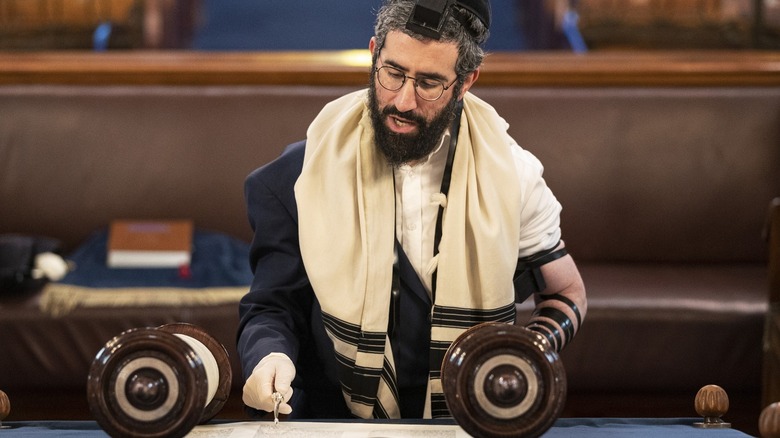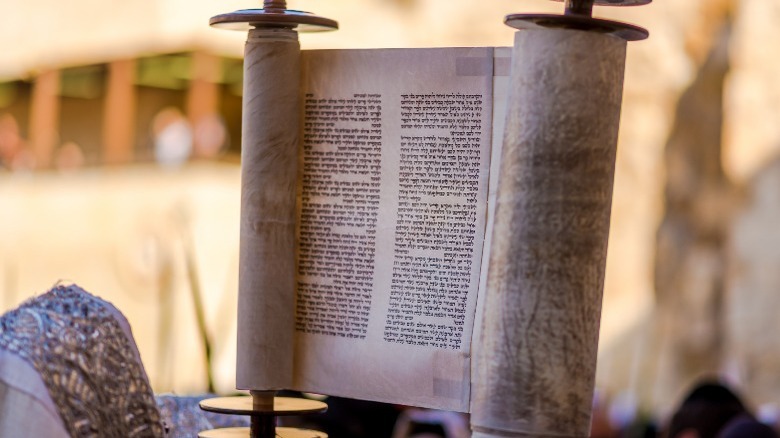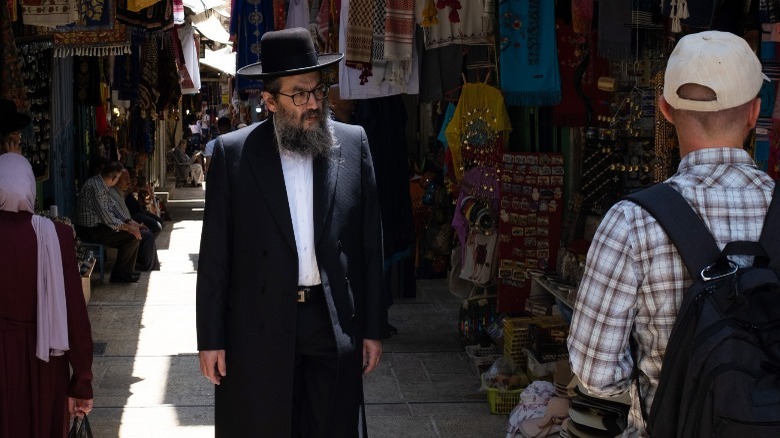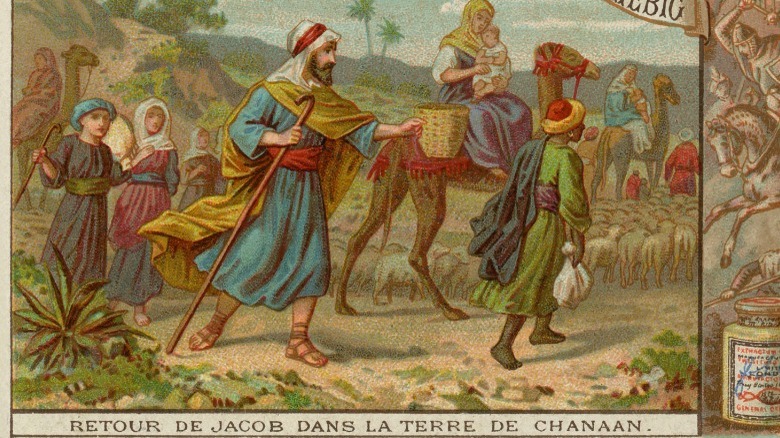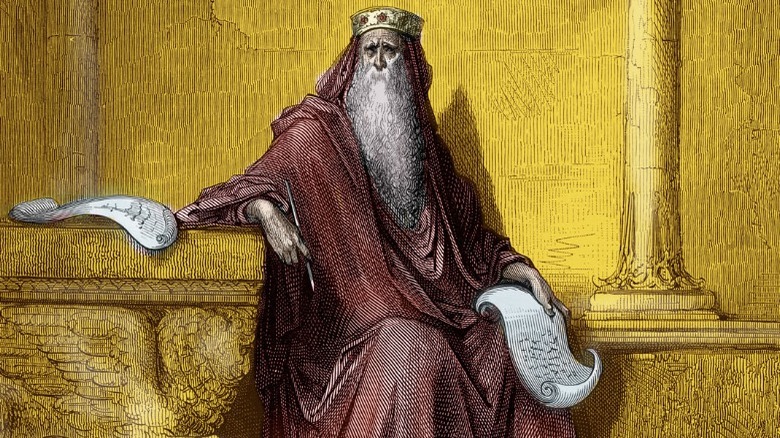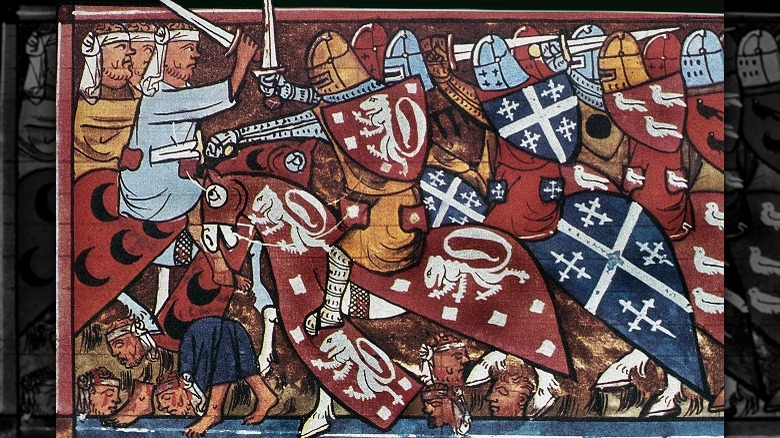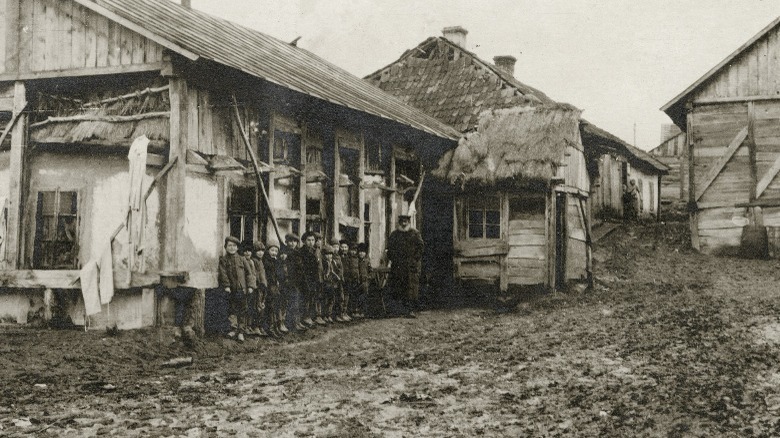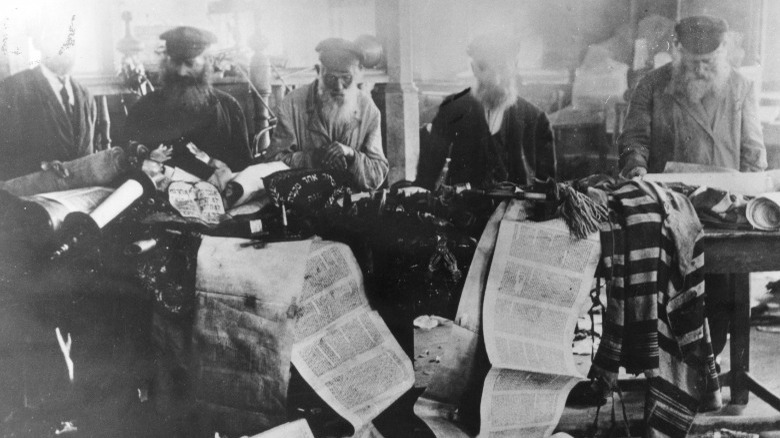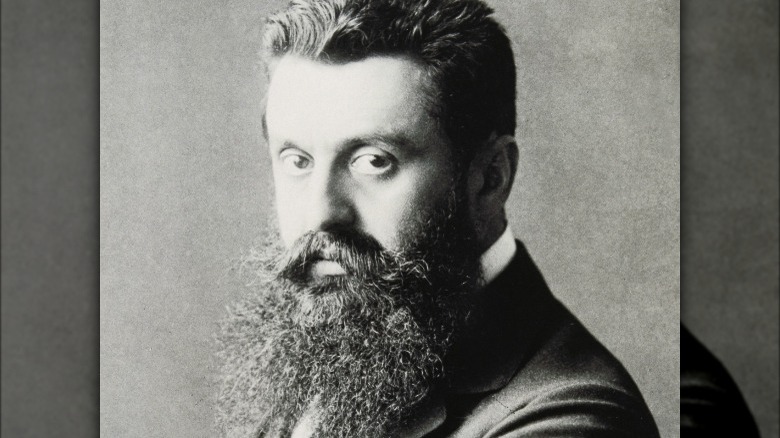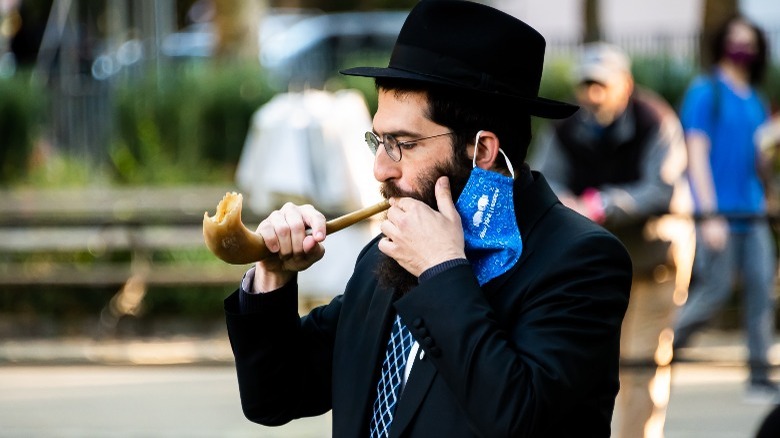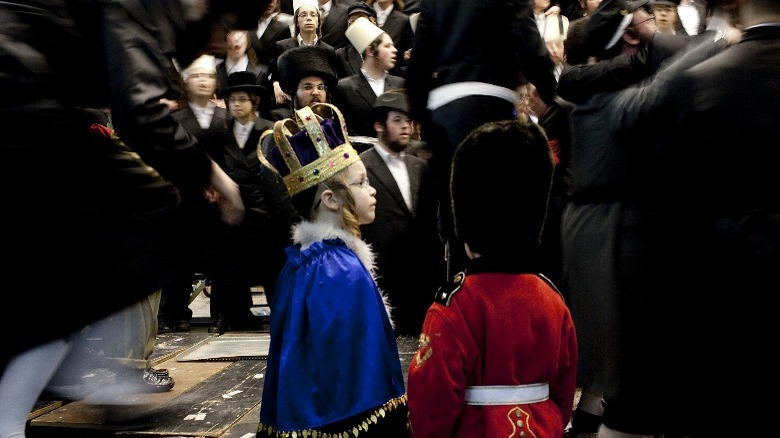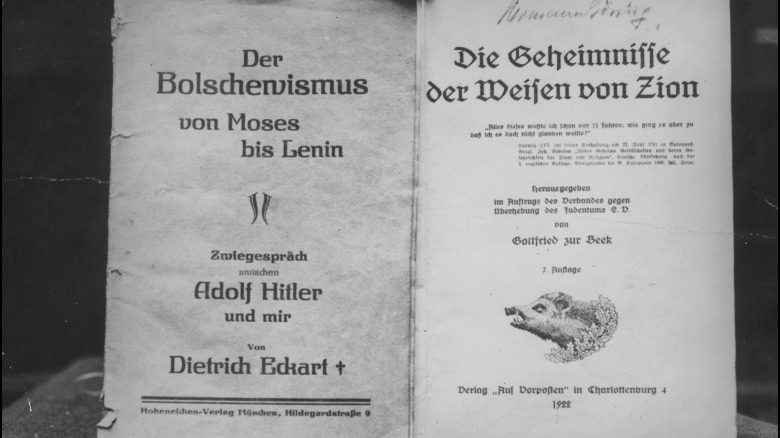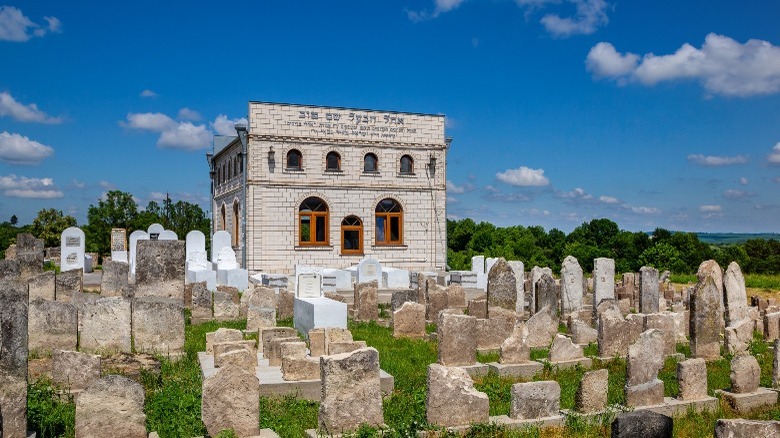The Untold Truth Of Judaism
Judaism is one of the oldest religions in the world that is still being practiced today. It dates back to nearly six millennia, and it is the first known monotheistic religion to have been established in the world (per History). According to Jewish tradition, Abraham is the first person to whom God spoke, and he is considered the patriarch of the religion. God and Abraham are said to have created a covenant, in which Jews would serve God in exchange for being delivered safely and securely into the land of Israel (via the BBC). Over a millennium later, God is said to have given Moses the Ten Commandments after leading the Jews out of bondage from the pharaohs in Egypt.
Modern Judaism takes several forms, the most prominent being orthodox, reform, and conservative Judaism. In 1948, the country of Israel was created, and Prime Minister David Ben-Gurion proclaimed it the first Jewish state in 2,000 years (via History). Judaism is an ancient culture full of rich history and tradition, but there is still a lot that even people familiar with it do not know. This is the untold truth of Judaism.
The main Jewish religious text is called the Tanakh
People familiar with Judaism have undoubtedly heard of the Torah and understand its significance. Still, some people may not realize that the Torah is just one of three religious texts to which the religion's followers look. In Judaism, the most important scripture is known as the Tanakh, a combination of three separate religious teachings (via the Jewish Virtual Library).
The first part of the Tanakh is the Torah — also known as the Hebrew Bible or Pentateuch — which contains the five books of Moses (Genesis, Exodus, Leviticus, Numbers, and Deuteronomy). The second part is called the Nevi'im, or Prophets, and is split into two sections: the Former Prophets and the Latter Prophets (via Britannica). The final set of teachings is known as the Ketuvim, which means Writings. The Ketuvim is composed mainly of theology and poetry. The Torah, according to Britannica, is said to have originally been given to Moses on Mount Sinai by God and is the oldest of the teachings. The Nevi'im, it added, is thought to have become fixed between the 2nd century B.C.E. and the 1st century C.E., and the Ketuvim was first conceived in the 6th century B.C.E. but was not considered canonical until the 2nd century C.E.
The word Tanakh is an acronym and comes from a combination of the Hebrew letters of the three sets of teachings; the Torah, Nevi'im, Ketuvim: TaNaKh.
Less than 1% of the world is Jewish
Being the world's oldest monotheistic religion and the progenitor of Christianity and Islam, one might expect the Jewish population in the world to be relatively robust. However, per the Pew Research Center, as of 2010, Jews made up only 0.2% of the world's population — the smallest percentage among the major organized religions. More than 80 times more people identified as unaffiliated rather than Jewish.
According to the Jewish Virtual Library, there were roughly 15 million Jews worldwide as of 2021. The vast majority of these, over 90%, reside in either the United States or Israel. There is also a significant population in France and Canada, as they have just under a half-million Jews each. However, in Europe today, there are just 1.3 million Jews, a chilling reminder that over 6 million were killed during the Holocaust in WWII.
In Africa, less than 60,000 Jews are spread throughout the continent, nearly all living in South Africa. In the Caribbean and South America, there are also many small enclaves of Judaism, most prominently in Argentina and Brazil. There are even Jewish communities in Jamaica and the Virgin Islands. The Jewish diaspora is spread throughout the world, and there are Jewish communities on every continent except Antarctica.
There were once 12 Tribes of Israel
Though they have all now been lost to history for over 2,500 years, there once were 12 Tribes of Israel in the ancient kingdom of Canaan — otherwise known as Palestine. According to the Tanakh, it was under the leadership of Joshua, Moses' successor, that the Hebrew people conquered Canaan (per Britannica). Afterward, Joshua decided to split the land between Jacob's 12 sons and grandsons. Jacob later had his name changed to Israel, which is why they became known as the 12 Tribes of Israel.
According to scripture, Jacob is a descendant of Abraham and the son of Isaac. He had his 12 descendants through his wives, Rachel and Leah, and their servants, Zilpah and Bilhah. The tribes ran Canaan together as a tribal confederation for centuries, fighting together against their enemies (via WorldHistory.org). Finally, after King David conquered Jerusalem and built the First Temple, all of the tribes were united and ruled together as the Kingdom of Israel — instead of just a joint confederation.
However, disagreements over the conscription of labor soon arose, and 10 tribes broke off to form their own kingdom in the north. These tribes were eventually defeated by the Assyrians in the 8th century and scattered to history. Only the tribes of Benjamin and Judah remained, and most modern Jews trace their lineage through them, Britannica also reported.
The first Jewish temple was built in the 10th century BCE
Even though Judaism is over 3,500 years old, the history of what is considered the first Jewish temple is much shorter. In the early 10th century, the Jewish King David conquered the city of Jerusalem in Canaan with his army (via Britannica). This was a significant event in Jewish history because it united King David with the Ark of the Covenant in Jerusalem (a holy city), and the city became a symbol of unity among the 12 Tribes of Israel.
It was David who decided to construct a permanent temple to house the ark in Jerusalem on Mount Moriah — one of the holiest mountains in Jewish scripture. It was under David's son, King Solomon, that the First Temple was finally completed in the mid-10th century B.C.E. Not only did the Temple house the ark, but it was also a gathering place for worship.
However, it was destroyed in the 6th century B.C.E. by the Babylonians. Today, none of the original First Temple remains intact. In 26 C.E., the building of the Second Temple was completed — a modest reconstruction of the first. All that remains there today is a retaining wall from the Second Temple period, which is known as the Western or Wailing Wall and is a frequent destination for worshippers.
Many Jews were victims of the Crusades
While the Crusades are often seen as just Christian military offensives against the Muslim communities in Palestine, there was a lot of violence directed toward Jews in Europe as well (via the Jewish Virtual Library). There were eight Crusades in all, and the first was initiated by Pope Urban II in 1095 when he gave a speech calling for the land of Palestine to be reclaimed from its Muslim rulers. Stories of violent abuses against Christians fueled widespread antagonism towards the Muslims, and upwards of 100,000 people responded and created the Crusader armies.
Many of the first Crusader armies were formed in France and marched through Germany on their way to the holy lands. In several German towns, including Cologne, Mainz, Worms, and Speyer, Jews were either massacred by the Crusader armies or committed suicide to avoid conversion. The Crusaders attacked them over alleged plots by Jews against the Christians, such as the erroneous belief they sacrificed Christians every year. This pattern repeated itself during the other seven Crusades, and Jews consistently faced violence from Crusader armies for centuries.
Jews in the holy lands also faced violence during the Crusades, as many fought with their Muslim neighbors and were killed alongside them. Many Jews also fled Jerusalem after the Crusader armies arrived, fearing either death or being sold into slavery.
Jews were forced to live in shtetls in imperial Russia
During the 18th century, as Russia slowly partitioned Poland out of existence and claimed the Eastern portion of its former territory, significant numbers of Jews were absorbed into the Russian empire (via Britannica). In 1791, Catherine the Great decreed a set of laws that restricted the area that Jews were allowed to live in Russia to only the newly conquered areas of former Poland. This area became known as the Pale of Settlement.
The Pale consisted of 25 provinces, including parts of modern-day Ukraine, Belarus, Lithuania, and Crimea (per AISH). Jews were forced out of other Russian areas, like Moscow and St. Petersburg, and made to live in the Pale. They were also forced to live in Jewish-only enclaves known as shtetls. Shtetls had developed in the Poland-Lithuania area in the 16th century and continued as Jewish cultural centers through their absorption into Russia (via Jewish Virtual Library).
Shtetl life generally consisted of three things, the synagogue, the market, and home. Judaism was practiced both at home and in the synagogue, and the market was the one place where Jews came into contact with non-Jewish people — the goyim. The Pale of Settlement was eventually dissolved in 1917 during the Russian Revolution, and shtetl life ceased to exist for the most part after that.
Jews faced terrifying pogroms in Europe before the Holocaust
Throughout Europe's late-19th and early to mid-20th centuries, Jewish people were regularly subjected to violence. They were often the victims of increasingly harsh pogroms, which were essentially government-approved orgies of violence directed against Jews (per History). The first widespread pogroms occurred in the 1880s in imperial Russia, and they were generated in response to the assassination of Tsar Alexander II. Dozens sprung up throughout modern-day Ukraine and Poland, and anti-Semitic mobs murdered several Jews.
More pogroms occurred in the early-1900s in Russia, beginning with the 1902 attack by Cossacks on Jews in Czestochowa, Poland. Several pogroms also happened in Kishinev and Kyiv, accompanied by widespread sexual violence and arson. In 1906, Tsarist soldiers and police officials murdered 200 Jews in Bialystok and blamed them for assassinating the police chief.
Between WWI and WWII, there were even more violent reprisals against Jews in Ukraine and Poland. During the Polish-Ukrainian War and Ukrainian Civil War, thousands of Jews were murdered, and many more women were sexually abused. After the Nazis took control of Germany, they committed countless pogroms and atrocities against Jews, culminating in the ethnic cleansing of the Holocaust.
If you or anyone you know has been a victim of sexual assault, help is available. Visit the Rape, Abuse & Incest National Network website or contact RAINN's National Helpline at 1-800-656-HOPE (4673).
Zionism was founded in Eastern Europe
Today, the country of Israel is synonymous with Jewish people and the movement of Zionism. However, Zionism predates the founding of Israel by nearly a century, stretching back into the mid-1800s. According to Colin Shindler in "A History of Modern Israel," Zionism was created to "safeguard the existence of Jewish people from physical extinction and persecution ... and assimilation and disintegration." In addition to the violent pogroms being committed against them in Eastern Europe, they found it hard to be accepted in Western Europe and faced discrimination.
Theodor Herzl (above middle) wrote one of the earliest Zionist tracts, "The Jewish State," in 1895. Herzl wrote about the potential creation of a Jewish state, which he thought was the solution to the problem of their marginalized existence in Europe. Though many Jewish philosophers of the time ridiculed Herzl, he successfully popularized the idea of Zionism among many European Jews.
In 1882, the first Zionist settlers arrived in Palestine from Russia and established the first modern Zionist settlement. Following the pogroms in the early-1900s in Kishinev, about 30,000 Jews fled Russia and came to colonize Palestine before WWI broke out. Eventually, Israel was created in 1948 as the culmination of the Zionist movement (via History).
Archaeology shows ancient Jews did not always keep kosher
One of the most important dietary laws for followers of orthodox Judaism is kashruth or the practice of staying kosher. According to Rabbi Dr. Bradley Shavit Artson on My Jewish Learning, these dietary laws were originally given by the Torah, though they came without a biblical justification. The kashruth laws are relatively extensive and include prohibitions on eating specific mammals, birds, and fish, as well as on all insects and reptiles. According to Jewish legend, when faced with oppressors, ancient Jews would choose to die rather than break kashruth.
However, new archeological research has started to cast doubt on whether or not Jews always maintained strict adherence to kosher dietary laws in the first millennium B.C.E. According to Smithsonian Magazine, researchers have discovered the existence of non-kosher food in the diets of Jews during both the Persian Period and the latter part of the Kingdom of Israel. During the time of the Kingdom of Israel, in the 8th century B.C.E., there is evidence that the Jews in the north ate a lot of pork, which is non-kosher. During the Persian Period, from 539-332 B.C.E., there were traces of skate, shark, and catfish in the Jews' diet, none of which have fins and scales — making them also non-kosher. This is not to say the ancient Jewish people never followed kashruth, but it might not have been followed 100% of the time, as legends suggest.
The High Holy Days are the most important Jewish holidays
Most people who know about the Jewish culture are familiar with holidays like Hanukkah and Shabbat, but they are considered relatively minor holidays within the Jewish faith. The biggest celebrations for the Jewish people are the High Holy Days, which include Rosh Hashanah and Yom Kippur (via the University of Colorado). Rosh Hashanah is the celebration of the Jewish new year based on the Jewish calendar. Yom Kippur is considered the holiest day of the year and is known as the "Day of Atonement."
Rosh Hashanah is celebrated with the blowing of the shofar to commemorate Abraham's willingness to sacrifice his son Isaac to God and also involves eating apple slices with honey — "symbolizing the desire for a sweet year." Ten days after Rosh Hashanah, Yom Kippur is celebrated, and the entire period is known as the "Days of Awe." Yom Kippur is commemorated through fasting and asking forgiveness for the previous year's sins. Immediately following the High Holy Days are the festivals of Sukkot, Shemini Atzeret, and Simchat Torah. They celebrate agriculture and the reading of the Torah and are also connected like the High Holy Days.
Purim celebrates a Persian Jewish Queen
Though it is often erroneously referred to as a Jewish Halloween because of the costumes people wear during modern celebrations, Purim is an incredibly important holiday in Judaism. According to the Jewish education website Chabad, the story takes place around the 4th century B.C.E. in the Persian Empire. The Persian King Ahasuerus took a Jewish Queen, Esther, though he did not realize at the time she was Jewish. Meanwhile, the anti-Semitic Persian prime minister, Haman, had gotten into a feud with the Jewish leader Mordechai, which ended with the King sentencing all the Jews in Persia to death.
Fearing for her people, Queen Esther held a feast that included both Haman and King Ahasuerus. At the banquet, Esther revealed her Jewish lineage and asked the King to save her people. The King was won over to her side, and he ordered that Haman be hanged, and Mordechai become the new prime minister (via Britannica). The Jews then attacked all of their enemies on the date of their original execution with the King's blessing, successfully defeating them on the battlefield. The celebration of their victory became the story of Purim, and it is celebrated every year.
Jews have subjected to bizarre conspiracy theories
Throughout history, the Jewish people have unfortunately been the victims of abhorrent and bizarre conspiracy theories. One of the most widespread is related to the "Protocols of the Elders of Zion" (pictured above in German), a forged document purported to be from the First Zionist Congress in Basel, Switzerland, in 1897 (via Britannica). The document purports the conspiracy that the Jews and Freemasons had agreed in Basel to take over the world at the expense of Christians. It originally came to light in Russia in 1903, and it was not until 1921 that it was first publicly investigated as false.
Another fake conspiracy that emerged from Russia is the fictitious Doctor's Plot, which first was published in the journal Pravda in January 1953 by the Soviet Government (via Dr. A. Mark Clarfield). The plot was supposed that Zionists and the west had allied together to kill off the Soviet leadership systematically. It even involved a show trial, though the alleged conspirators were all exonerated upon Stalin's death in March. The trial was going to be the first step in a plan to exile the entire Jewish population to the Gulag in Siberia and likely would have proceeded if not for Stalin's death.
The phenomenon of Jewish mysticism: Kabbalah
The majority of contemporary Jews identify themselves as belonging to either the Orthodox, Conservative, or Reform congregations of Judaism. However, there is another aspect of Judaism that is just as important but not nearly as mainstream: Kabbalah, the practice of Jewish mysticism. Kabbalah is not a monolithic interpretation of Judaism but is instead a general term given to a broad range of Jewish mystical worship (per the Jewish Virtual Library). It is mainly an oral tradition, and followers claim to have secret knowledge of unwritten Jewish scriptures (via Britannica).
Kabbalah first appeared in the first century C.E., and the first book related to mysticism is thought to have been published sometime between 200-500 C.E. One of the most important manuscripts in Kabbalah, the Zohar, was revealed in the 13th century –- though many modern Rabbis now regard it as a forgery. It is written in Aramaic as a commentary on the Torah, and followers of Kabbalah are known as mekubbalim. Kabbalah is still practiced today and studied by many Hasidic and counterculture non-Orthodox Jews.
